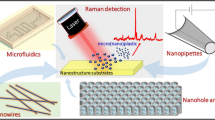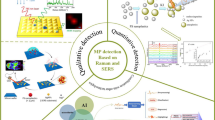Abstract
Research on the microplastics (MPs) is developing towards smaller size, but corresponding methods for the rapid and accurate detection of microplastics, especially nanoplastics still present challenge. In this work, a novel surface and volume enhanced Raman spectroscopy substrate was developed for the rapid detection of microplastic particles below 5 μm. The gold nanoparticles (NPs) were deposited onto the surface and into the V-shaped nanopores of anodized aluminum oxide (AAO) through magnetron sputtering or ion sputtering, and then AuNPs@V-shaped AAO SERS substrate was obtained and studied for microplastic detection. SERS performance of AuNPs@V-shaped AAO SERS substrate was evaluated through the detection of polystyrene and polymethyl methacrylate microspheres. Results indicated that individual polystyrene sphere with a diameter of 1 μm can be well detected on AuNPs@V-shaped AAO SERS substrate, and the maximum enhancement factor (EF) can reach 20. In addition, microplastics in ambient atmospheric samples were collected and tested to verify the effectiveness of the AuNPs@V-shaped AAO SERS substrate in the real environment. This study provides a rapid, economic and simple method for detecting and identifying microplastics with small size.

Similar content being viewed by others
References
Anema J R, Brolo A G, Felten A, Bittencourt C (2010). Surface-enhanced Raman scattering from polystyrene on gold clusters. Journal of Raman Spectroscopy, 41(7): 745–751
Araujo C F, Nolasco M M, Ribeiro A M P, Ribeiro-Claro P J A (2018). Identification of microplastics using Raman spectroscopy: Latest developments and future prospects. Water Research, 142: 426–440
Bergmann M, Wirzberger V, Krumpen T, Lorenz C, Primpke S, Tekman M B, Gerdts G (2017). High quantities of microplastic in arctic deep-sea sediments from the HAUSGARTEN observatory. Environmental Science & Technology, 51(19): 11000–11010
Catarino A I, Macchia V, Sanderson W G, Thompson R C, Henry T B (2018). Low levels of microplastics (MP) in wild mussels indicate that MP ingestion by humans is minimal compared to exposure via household fibres fallout during a meal. Environmental Pollution, 237: 675–684
Chen G, Feng Q, Wang J (2020). Mini-review of microplastics in the atmosphere and their risks to humans. Science of the Total Environment, 703: 135504
Foulon V, Le Roux F, Lambert C, Huvet A, Soudant P, Paul-Pont I (2016). Colonization of polystyrene microparticles by vibrio crassostreae: Light and electron microscopic investigation. Environmental Science & Technology, 50(20): 10988–10996
Fu Y, Kuppe C, Valev V K, Fu H, Zhang L, Chen J (2017). Surface-enhanced Raman spectroscopy: A facile and rapid method for the chemical component study of individual atmospheric aerosol. Environmental Science & Technology, 51(11): 6260–6267
He S, Xie W, Fang S, Huang X, Zhou D, Zhang Z, Du J, Du C, Wang D (2019). Silver films coated inverted cone-shaped nanopore array anodic aluminum oxide membranes for SERS analysis of trace molecular orientation. Applied Surface Science, 488: 707–713
Heller E J, Yang Y, Kocia L, Chen W, Fang S, Borunda M, Kaxiras E (2016). Theory of graphene raman scattering. ACS Nano, 10(2): 2803–2818
Hendrickson E, Minor E C, Schreiner K (2018). Microplastic abundance and composition in western lake superior as determined via microscopy, Pyr-GC/MS, and FTIR. Environmental Science & Technology, 52(4): 1787–1796
Huang D, Tao J, Cheng M, Deng R, Chen S, Yin L, Li R (2021). Microplastics and nanoplastics in the environment: Macroscopic transport and effects on creatures. Journal of Hazardous Materials, 407: 124399
Koelmans A A, Bakir A, Burton G A, Janssen C R (2016). Microplastic as a vector for chemicals in the aquatic environment: Critical review and Model-Supported reinterpretation of empirical studies. Environmental Science & Technology, 50(7): 3315–3326
Koelmans A A, Mohamed Nor N H, Hermsen E, Kooi M, Mintenig S M, De France J (2019). Microplastics in freshwaters and drinking water: Critical review and assessment of data quality. Water Research, 155: 410–422
Langer J, Jimenez de Aberasturi D, Aizpurua J, Alvarez-Puebla R A, Auguié B, Baumberg J J, Bazan G C, Bell S E J, Boisen A, Brolo A G, et al. (2020). Present and future of surface-enhanced Raman scattering. ACS Nano, 14(1): 28–117
Law K L, Thompson R C (2014). Microplastics in the seas. Science, 345(6193): 144–145
Lê Q T, Ly N H, Kim M K, Lim S H, Son S J, Zoh K D, Joo S W (2021). Nanostructured Raman substrates for the sensitive detection of submicrometer-sized plastic pollutants in water. Journal of Hazardous Materials, 402: 123499
Liu K, Wu T, Wang X, Song Z, Zong C, Wei N, Li D (2019). Consistent transport of terrestrial microplastics to the ocean through atmosphere. Environmental Science & Technology, 53(18): 10612–10619
Lv L, He L, Jiang S, Chen J, Zhou C, Qu J, Lu Y, Hong P, Sun S, Li C (2020). In situ surface-enhanced Raman spectroscopy for detecting microplastics and nanoplastics in aquatic environments. Science of the Total Environment, 728: 138449
Mohamed Nor N H, Kooi M, Diepens N J, Koelmans A A (2021). Lifetime accumulation of microplastic in children and adults. Environmental Science & Technology, 55(8): 5084–5096
Nagaura T, Takeuchi F, Inoue S (2008). Fabrication and structural control of anodic alumina films with inverted cone porous structure using multi-step anodizing. Electrochimica Acta, 53(5): 2109–2114
Parker J, Feldman D, Ashkin M (1967). Raman scattering by silicon and germanium. Physical Review, 155(3): 712–714
Ragusa A, Svelato A, Santacroce C, Catalano P, Notarstefano V, Carnevali O, Papa F, Rongioletti M C A, Baiocco F, Draghi S, D’Amore E, Rinaldo D, Matta M, Giorgini E (2021). Plasticenta: First evidence of microplastics in human placenta. Environment International, 146: 106274
Rillig M C, Lehmann A (2020). Microplastic in terrestrial ecosystems. Science, 368(6498): 1430–1431
Schwabl P, Köppel S, Königshofer P, Bucsics T, Trauner M, Reiberger T, Liebmann B (2019). Detection of various microplastics in human stool: A prospective case series. Annals of Internal Medicine, 7(171): 453–457
Seeley M E, Song B, Passie R, Hale R C (2020). Microplastics affect sedimentary microbial communities and nitrogen cycling. Nature Communications, 11(1): 2372
Shi G, Wang M, Zhu Y, Yan X, Pan S, Zhang A (2019). Nanoflower-like Ag/AAO SERS platform with quasi-photonic crystal nanostructure for efficient detection of goat serum. Current Applied Physics, 19(11): 1276–1285
Tekman M B, Wekerle C, Lorenz C, Primpke S, Hasemann C, Gerdts G, Bergmann M (2020). Tying up loose ends of microplastic pollution in the arctic: Distribution from the sea surface through the water column to deep-sea sediments at the HAUSGARTEN observatory. Environmental Science & Technology, 54(7): 4079–4090
Thompson R C, Olsen Y, Mitchell R P, Davis A, Rowland S J, John A W, McGonigle D, Russell A E (2004). Lost at sea: where is all the plastic?. Science, 304(5672): 838
Wang C, Zhao J, Xing B (2021). Environmental source, fate, and toxicity of microplastics. Journal of Hazardous Materials, 407: 124357
Wang L, Zhang J, Hou S, Sun H (2017). A simple method for quantifying polycarbonate and polyethylene terephthalate microplastics in environmental samples by liquid chromatography-tandem mass spectrometry. Environmental Science & Technology Letters, 4(12): 530–534
Wang X, Huang S, Hu S, Yan S, Ren B (2020). Fundamental understanding and applications of plasmon-enhanced Raman spectroscopy. Nature Reviews Physics, 2(5): 253–271
Xu G, Cheng H, Jones R, Feng Y, Gong K, Li K, Fang X, Tahir M A, Valev V K, Zhang L (2020). Surface-enhanced Raman spectroscopy facilitates the detection of microplastics < 1 µm in the environment. Environmental Science & Technology, 54(24): 15594–15603
Zhang Q, Xu E G, Li J, Chen Q, Ma L, Zeng E Y, Shi H (2020a). A review of microplastics in table salt, drinking water, and air: Direct human exposure. Environmental Science & Technology, 54(7): 3740–3751
Zhang Y, Pu S, Lv X, Gao Y, Ge L (2020b). Global trends and prospects in microplastics research: A bibliometric analysis. Journal of Hazardous Materials, 400: 123110
Zhao J, Lin J, Li X, Zhao G, Zhang W (2015). Silver nanoparticles deposited inverse opal film as a highly active and uniform SERS substrate. Applied Surface Science, 347: 514–519
Zhu X, Huang W, Fang M, Liao Z, Wang Y, Xu L, Mu Q, Shi C, Lu C, Deng H, Dahlgren R, Shang X (2021). Airborne microplastic concentrations in five megacities of northern and southeast China. Environmental Science & Technology, 55(19): 12871–12881
Acknowledgements
The authors gratefully acknowledge financial support from the National Natural Science Foundation of China (Nos. 22176036, 21976030 and 22006020), the Natural Science Foundation of Shanghai (China) (No. 19ZR1471200).
Author information
Authors and Affiliations
Corresponding author
Additional information
Highlights
• V-shaped substrate was obtained for SERS analysis of microplastics (diameter ≈ 1 μm).
• Enhancement factor of V-shaped substrate can reach 20 in microplastics detection.
• V-shaped nanopore array can bring additional volume enhancement.
• V-shaped substrate was more economic in application compared to Klarite substrate.
Rights and permissions
About this article
Cite this article
Liu, J., Xu, G., Ruan, X. et al. V-shaped substrate for surface and volume enhanced Raman spectroscopic analysis of microplastics. Front. Environ. Sci. Eng. 16, 143 (2022). https://doi.org/10.1007/s11783-022-1578-8
Received:
Revised:
Accepted:
Published:
DOI: https://doi.org/10.1007/s11783-022-1578-8




